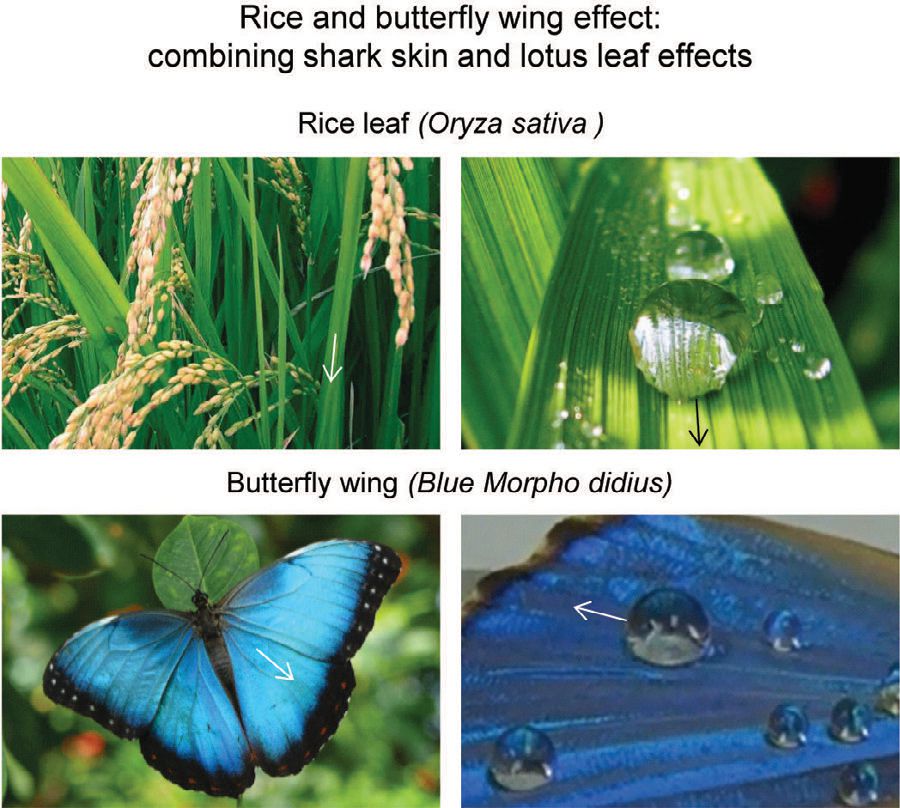Studying butterfly wings to reduce drag
Dr. Neil Canter, Contributing Editor | TLT Tech Beat April 2014
Butterfly wings exhibit superhydrophobic and self-cleaning properties that might be applicable in real-world applications.
KEY CONCEPTS
•
There are several examples of Mother Nature's work that show species have developed ways to reduce friction and wear in their environments.
•
One strategy used is to develop superhydrophobic coatings that can reduce the amount of drag seen in fluid flow and also are self-cleaning.
•
Butterfly wings display hierarchical scales that display these superhydrophobic properties.
IN THE EFFORT TO IMPROVE THE EFFICIENCY of machinery and to look for factors causing lubrication problems, researchers have looked at Mother Nature for guidance. There are examples in nature where organisms have developed ways to reduce friction and wear to survive in their environments.
One example was provided in a previous TLT article that described how mollusks can produce adhesive gels that enables them to adhere to moist surfaces to such an extent that the amount of force need to remove them is 200 kilopascals (
1). Key components instrumental in the performance of these adhesives are the metals iron, zinc and calcium, which are present in trace quantities.
STLE-fellow and Life-member Bharat Bhushan, Ohio Eminent Scholar and Winbigler Professor of Mechanical and Aerospace Engineering at The Ohio State University in Columbus, Ohio, discusses the properties of the lotus leaf. He says, “The Lotus Effect is attributed to this leaf displaying superhydrophobic properties that enables it to be water repellent and also exhibit the additional benefit of self-cleaning. The latter characteristic is realized due to the ability of water droplets to roll off the leaf, leading to the removal of contaminants that are mainly compatible with water.”
Superhydrophobic coatings are also desirable because they can reduce the amount of drag seen in fluid flow, leading to greater efficiency. Two approaches used to develop this effect are to apply a coating to a substrate or to include roughness in the surface structure.
The shark provides an interesting example of a low drag surface through its use of riblets on its skin that reduces frictional drag as the fish moves through the water. Bhushan says, “The shark needs to move through turbulent water at a fast pace to track down its prey. The riblets on the skin lift and pin vortices that can develop in the water, which reduces cross-stream fluid motion and reduces energy loss.”
The key for achieving the Lotus Effect is the use of rough, hierarchy structure combined with the presence of a waxy coating on the surface to enhance the superhydrophobic effect, and the key to the shark skin effect is to provide anisotropic riblets to reduce drag. Bharat says, “Several years ago, we came across a new species that seemed to exhibit many of the properties of lotus leaf and shark skin, enabling it to thrive in its environment. We decided to spend time studying this species to see what properties it exhibited that might be applicable for replication in real-world applications. The species is the butterfly.”
GIANT BLUE MORPHO BUTTERFLY
Bhushan and his associate, Gregory Bixler, determined that on the nanoscale, butterfly wings exhibit the key combination of superhydophobicity and self-cleaning. Bhushan says, “Butterfly wings are covered with hierarchical scales that exhibit these important properties. They are needed because butterflies are fragile and must have a mechanism in place to repel water and other contaminants in order to maintain their ability to fly.”
The researchers chose to study the wings from the butterfly species
Blue Morpho didius. Bhushan says, “We selected this species because it is a relatively large butterfly with wings that are approximately three-inches long.” Figure 3 shows images of the
Blue Morpho didius.
 Figure 3. The wings of the butterfly species, Blue Morpho didius display superhydropobic properties, leading to reduced drag and improved efficiency. (Courtesy of The Ohio State University)
Figure 3. The wings of the butterfly species, Blue Morpho didius display superhydropobic properties, leading to reduced drag and improved efficiency. (Courtesy of The Ohio State University)
Replicas of the butterfly wing were produced through the use of a two-step soft lithography molding procedure. Bhushan says, “We started by using a polymer such as dental cement in preparing a negative mold. Then polydimethylsiloxane is applied and cured on the first polymer to produce a precise positive replica. A fluorinated coating is used to separate the positive copy from the mold.”
The resulting replicas were characterized using scanning electron microscopy and digital camera images. Oil drag was measured by evaluating the pressure drop determined as white oil is pumped through the replicas. Measurements were taken under low-velocity and high-velocity conditions.
Bhushan says, “We found that the replicas displayed better performance under high-velocity conditions. This is anticipated because fluid flow under high velocity conditions can be turbulent, leading to the formation of vortices. Drag reduction is seen at high-velocity due to the formation of a thin oil film on the microstructure surface of the replica.” The researchers determined that the butterfly wing replica displayed a drag reduction of 6 percent.
To determine the superhydrophobicity, apparent contact angles were determined on the butterfly wings and their replicas. Differences were seen between butterfly wings and their replicas. Bhushan explains, “The reason is due to the presence of a hydrophobic wax on the butterfly wing creating the conditions for a high contact angle when exposed to water. In contrast, the untreated replicas are not nearly as hydrophobic and have much lower contact angles. This can be adjusted by applying a hydrophobic coating contacting the replicas.”
Bhushan believes that the structural information obtained on the butterfly wings can be applied to real-world applications. He says, “There is potential for reducing drag in many applications including moving blood through a nano-channel, pumping crude oil through a pipeline, reducing drag on the surface of an airplane wing and improving the efficiency in which a ship’s hull moves through water.
Further information can be found in a recent publication (
2) or by contacting Bhushan at
bhushan.2@osu.edu.
REFERENCES
1.
Canter, N. (2009), “Molluscan adhesive gels,” TLT,
65 (12), pp. 14-15.
2.
Bixler, G. and Bhushan, B. (2013), “Bioinspired micro-nanostructured surfaces for oil drag reduction in closed channel flow,”
Soft Matter,
9, pp. 1620-1635.
 Neil Canter heads his own consulting company, Chemical Solutions, in Willow Grove, Pa. Ideas for Tech Beat items can be sent to him at neilcanter@comcast.net
Neil Canter heads his own consulting company, Chemical Solutions, in Willow Grove, Pa. Ideas for Tech Beat items can be sent to him at neilcanter@comcast.net.